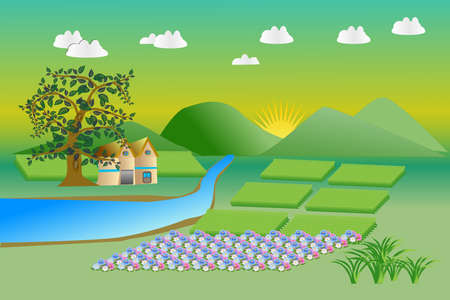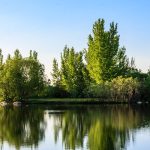Introduction: Why Go Beyond the Usual Spots
If you’re a true angler, you know there’s nothing quite like casting a line in a spot where the only sounds are birds overhead and water lapping against your boots. America is home to thousands of freshwater lakes, rivers, and streams—yet most fishermen crowd into the same well-known locations, hoping for that trophy catch. But what if you could escape the noise, leave the crowds behind, and discover secret fishing holes where the fish are plentiful and the experience is wild? Seeking out hidden gems isn’t just about finding better catches—it’s about reconnecting with nature, testing your skills in untouched waters, and enjoying peace you just can’t get at those popular lakes. For anglers craving adventure and solitude, exploring off-the-beaten-path fisheries across the United States offers not just great fishing, but also a chance to unplug, breathe deep, and experience America’s wild places as they were meant to be enjoyed—quiet, beautiful, and full of possibility.
2. Mountain Hideaways: Secluded Lakes and Streams
If you’re craving solitude and trophy-sized fish, the American Rockies and Appalachians are loaded with hidden freshwater gems. These mountain hideaways offer more than just stunning views—they deliver clean, cold waters where trout, bass, and panfish thrive away from the usual crowds. Here’s how to make the most of these off-the-grid fishing havens:
Rockies Retreats
The Rockies stretch from Montana down to Colorado, holding countless backcountry lakes and streams only accessible by hiking or ATV. Look for places like Montana’s Beartooth Plateau or Colorado’s Flat Tops Wilderness Area, where crystal-clear waters teem with cutthroat and brook trout.
Local Tips
- Arrive early for the best fishing—mountain fish feed most actively at dawn.
- Pack light but bring layers; weather changes fast in the mountains.
- Use natural baits or flies that mimic local insects for better bites.
Appalachian Adventures
The Appalachians, stretching from Georgia to Maine, are dotted with hidden creeks and ponds perfect for anglers seeking serenity. Try North Carolina’s Pisgah National Forest or Pennsylvania’s Loyalsock Creek for wild trout action.
| Region | Top Hidden Spots | Main Species |
|---|---|---|
| Rocky Mountains | Beartooth Plateau (MT), Flat Tops (CO) | Cutthroat, Brook Trout |
| Appalachians | Pisgah Forest (NC), Loyalsock Creek (PA) | Rainbow, Brown Trout |
Regulations to Remember
- Always check state fishing licenses and daily bag limits—regulations vary by location.
- Certain streams require catch-and-release only or use of barbless hooks to protect native populations.
Whether you’re bushwhacking through pine forests or following a mountain trail, these secluded waters promise fewer people and more adventure. Respect local rules, pack out what you pack in, and enjoy a true wilderness angling experience!

3. Southern Serenity: Out-of-the-Way Fishing Holes
Down in the American South, hidden rivers and winding bayous offer a slice of freshwater fishing paradise far from the usual crowds. If you’re looking for that perfect blend of wild scenery and abundant fish, places like Alabama’s Sipsey River or the cypress-lined creeks in Louisiana deliver. These waters are home to hard-fighting bass, feisty bluegill, and even catfish that’ll test your line. The best times to fish here are early morning or just before dusk when the temperatures drop and the fish get active. Local etiquette matters—be sure to respect private property lines, always pack out your trash, and greet fellow anglers with a friendly nod or a “how y’all doing?” It’s common courtesy in these parts to give other fishermen plenty of space and keep noise to a minimum to preserve the tranquil atmosphere. Bring bug spray, lightweight gear, and a sense of adventure—the South’s lesser-known fishing holes promise quiet mornings, lively bites, and memories made off the beaten path.
4. Midwestern Retreats: Underrated Lakes and Ponds
When you think of fishing in the Midwest, big names like Lake Michigan or Lake Erie might jump to mind. But if you’re looking to escape the crowds and connect with nature on your own terms, the heartland has a treasure trove of hidden lakes and quiet ponds. Wisconsin and Michigan, along with neighboring states, offer peaceful retreats where anglers can cast a line in solitude and still hook into some serious freshwater action.
Wisconsin’s Quiet Corners
Wisconsin is known for its “Up North” lakes, but beyond the popular tourist spots are countless smaller waters that locals keep secret. Take Turtle-Flambeau Flowage—less crowded than the more famous Eagle River Chain, yet loaded with walleye, musky, and smallmouth bass. Or head to Lost Land Lake, tucked away from busy roads, where you’ll find northern pike and panfish ready to bite all season long.
Michigan’s Hidden Gems
Michigan boasts over 11,000 inland lakes, so it’s no surprise some fly under the radar. Try Bass Lake near Traverse City for largemouth bass or explore Crooked Lake in Emmet County—both offer serenity and impressive catches. For those seeking trout, the clear spring-fed ponds around Grayling are perfect for a back-to-basics angling adventure.
Species You’ll Find
| Location | Main Species |
|---|---|
| Turtle-Flambeau Flowage (WI) | Walleye, Musky, Smallmouth Bass |
| Lost Land Lake (WI) | Northern Pike, Panfish |
| Bass Lake (MI) | Largemouth Bass |
| Crooked Lake (MI) | Panfish, Smallmouth Bass |
| Grayling Ponds (MI) | Brook Trout, Rainbow Trout |
Camping & Outdoor Options
The best part about these hidden spots? Many are surrounded by state forests or county parks with rustic campgrounds right on the water. Pitch your tent at Flambeau River State Forest after a day of chasing musky, or reserve a lakeside site at Interlochen State Park in Michigan for easy access to multiple lakes. Most sites come equipped with fire pits and basic amenities—perfect for grilling your catch or swapping stories around the campfire.
Pro Tip:
Pack light but don’t forget bug spray and rain gear—the Midwest is notorious for sudden weather changes and hungry mosquitoes. Whether you’re casting from shore or paddling a canoe into a secluded cove, these underrated lakes promise solitude and solid fishing that rivals any bucket-list destination.
5. Western Wonders: Remote Wilderness Waters
If you’re dreaming of true solitude and untamed beauty, look no further than the remote freshwater fishing gems tucked away in the wilds of Montana and Idaho. These states are renowned for their pristine rivers, crystal-clear mountain lakes, and miles of untouched wilderness—perfect for anglers who crave both adventure and isolation.
Montana: Big Sky Country’s Best-Kept Secrets
Skip the crowded hotspots and set your sights on lesser-known waterways like the Bighorn Backcountry Lakes or the upper stretches of the Yaak River. Here, native trout thrive in icy, oxygen-rich waters surrounded by pine forests and rugged peaks. Pack light but don’t skimp on essentials: weather can change fast at elevation, so bring layers, waterproof gear, and a reliable map or GPS unit.
Idaho: Off-the-Grid Fishing Bliss
In Idaho, discover hidden havens such as the Frank Church–River of No Return Wilderness or secluded corners of Priest Lake. Access may require a hike or even a paddle-in approach—perfect for those who enjoy a challenge. If you venture deep into these areas, be prepared to encounter wildlife and variable terrain. A well-stocked survival kit (including a fire starter, emergency blanket, water filter, and first aid supplies) is a must.
Practical Survival Tips for Remote Fishing Adventures
- Tell someone your plan: Always let a friend or family member know where you’re going and when you expect to return.
- Navigation matters: Even experienced outdoorsmen can get turned around in dense forest or along winding riverbanks—carry a compass and backup power for electronic devices.
- Pack smart: Bring extra food, water purification tablets, and bear spray if you’re in grizzly country.
- Leave no trace: Respect these wild places by packing out all trash and minimizing your impact on fragile ecosystems.
Your Next Great Adventure Awaits
The remote waters of Montana and Idaho aren’t just fishing spots—they’re gateways to self-reliance and serenity. With careful preparation, you’ll escape the crowds and experience some of America’s last true wilderness fishing adventures.
6. Tips for Discovering Your Own Secret Spots
Uncovering your own hidden freshwater fishing gems is half the adventure—and it pays off in peace, solitude, and unforgettable catches. Here’s how to get started:
Do Your Homework
Start with thorough research. Dig into state fish and wildlife websites, topographic maps, online forums like Fishbrain or local Reddit threads, and even old-school guidebooks. Sometimes, the best spots are those with little online presence—so don’t be afraid to get creative with your sources.
Scout the Terrain
Once you’ve got a few leads, lace up your boots. Use satellite imagery on Google Maps or apps like OnX Hunt to spot off-the-beaten-path lakes, creeks, or backwater sloughs. Take note of access points—many hidden gems require a hike or paddle to reach. Consider scouting at different times of day to catch subtle patterns in water clarity or fish movement.
Prep Like a Pro
Packing for these secret spots isn’t like heading to the local pier. Bring a backpack with extra water, snacks, a first aid kit, a map and compass (or fully charged GPS), bug spray, and weather-appropriate clothing. Always let someone know where you’re headed and when you expect to be back.
Safety First in Unfamiliar Terrain
Hidden locations often mean rugged terrain—watch out for slippery banks, unexpected drop-offs, or wildlife encounters. Dress in layers and wear sturdy boots. When venturing solo, carry a whistle or personal locator beacon for emergencies.
Leave No Trace: Respect Nature’s Gifts
The privilege of enjoying these untouched waters comes with responsibility. Pack out all trash—including fishing line and bait containers—stick to established trails when possible, and avoid disturbing wildlife or sensitive habitats. Practicing Leave No Trace ethics ensures that these secret spots stay pristine for future anglers.
With smart planning and respect for nature, finding your own freshwater fishing haven is more than just possible—it’s an adventure that keeps giving back every season.
7. Conclusion: Make Every Cast Count
As you set out to explore the hidden freshwater fishing gems scattered across the United States, remember that every cast is more than just a shot at landing the big one—its a chance to reconnect with nature, challenge yourself, and create lasting memories far from the crowds. Whether youre trekking along a remote Appalachian creek or casting into a quiet lake in the Pacific Northwest, each spot offers its own unique adventure waiting to be discovered.
Respecting these wild places is key. Leave no trace, follow local regulations, and practice catch-and-release whenever possible to help preserve these secret havens for future anglers. Dont be afraid to step off the beaten path and try new locations. The thrill of stumbling upon your own private fishing paradise is well worth the effort, and you might just find your new favorite spot where solitude and trophy fish await.
So grab your gear, study those maps, and get ready to make every cast count. The next hidden gem could be just around the bend—waiting for someone willing to explore, respect, and truly experience Americas great outdoors.


